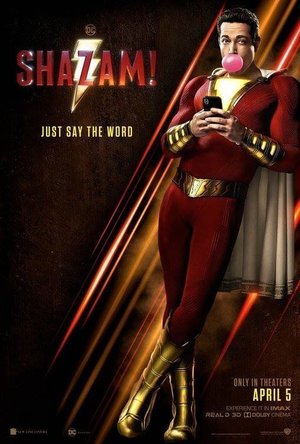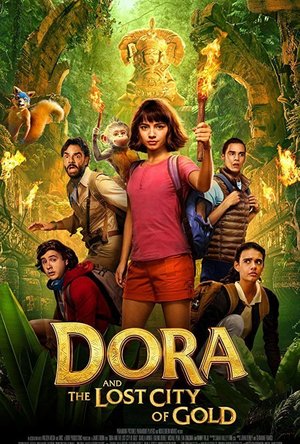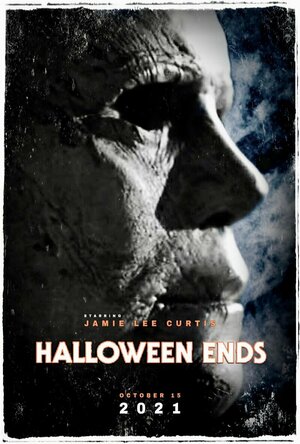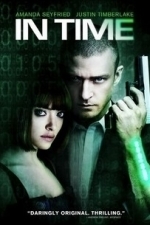Search
Search results
Charlie Cobra Reviews (1840 KP) rated Shazam! (2019) in Movies
Jul 7, 2020
Fun Filled Family Event
Shazam! is a 2019 superhero movie based on the DC Comics character. Produced by New Line Cinema and distributed by Warner Bros. Pictures, it is the first live-action film version of the character since 1941. The film is also directed by David F. Sandberg from a screenplay by Henry Gayden and story by Henry Hayden and Darren Lemke. Starring Zachary Levi, Asher Angel, Mark Strong, Jack Dylan Grazer, and Djimon Hounsou.
In 1974 Upstate New York, the ancient wizard Shazam magically transports Thaddeus Sivana (Ethan Pugiotto) to the Rock of Eternity, a hidden magical temple. Shazam, the last of the Council of Seven Wizards, explains that he has been searching for centuries for a champion who is "pure of heart". Released upon the ancient world, and now trapped in statues within the Rock, the Seven Deadly Sins tempt Thaddeus with promises of power. Banished back to Earth as unworthy of being a champion for succumbing to the sins, Thaddeus causes an accident while traveling with his family which leaves his father severely injured. Searching for his birth mother in present day Philadelphia, foster kid Billy Batson (Angel Asher) runs a foul of the law and is placed in a group home with 5 other foster kids run by Victor (Cooper Andrews) and Rosa Vasquez (Marta Milans). Freddy Freeman (Jack Dylan Frazer) is one of the five foster kids, an amateur superhero expert, and his new roommate. Now an adult Thaddeus (Mark Strong) discovers how to return to the Rock and acquire the power he was denied as a child.
This movie was a ton of fun. I don't think I've laughed out loud in a comic book movie this much since Ant-Man. This movie was really good. It had its silliness in certain parts but still did well in building tension and having its serious parts. Also it was well done on how the story played on your emotions for a lot of the different characters. I love the way the foster family and siblings came into play throughout the film. The special effects were really good, especially the monsters and even though you know Zachary Levi is in a muscle suit (which i initially disliked) it didn't even matter. The plot was good although some of it seemed recycled which bothered me slightly. The dialogue was good, some of it silly, which seemed appropriate for the character being younger than he looks when he is Shazam. But I didn't have much to complain about. I never saw one of the major twists coming at the end, so that really surprised me. If you're looking for a fun movie to watch, with family or friends or a superhero movie that will also make you laugh, Shazam is the one to choose. I give this movie a 8/10.
In 1974 Upstate New York, the ancient wizard Shazam magically transports Thaddeus Sivana (Ethan Pugiotto) to the Rock of Eternity, a hidden magical temple. Shazam, the last of the Council of Seven Wizards, explains that he has been searching for centuries for a champion who is "pure of heart". Released upon the ancient world, and now trapped in statues within the Rock, the Seven Deadly Sins tempt Thaddeus with promises of power. Banished back to Earth as unworthy of being a champion for succumbing to the sins, Thaddeus causes an accident while traveling with his family which leaves his father severely injured. Searching for his birth mother in present day Philadelphia, foster kid Billy Batson (Angel Asher) runs a foul of the law and is placed in a group home with 5 other foster kids run by Victor (Cooper Andrews) and Rosa Vasquez (Marta Milans). Freddy Freeman (Jack Dylan Frazer) is one of the five foster kids, an amateur superhero expert, and his new roommate. Now an adult Thaddeus (Mark Strong) discovers how to return to the Rock and acquire the power he was denied as a child.
This movie was a ton of fun. I don't think I've laughed out loud in a comic book movie this much since Ant-Man. This movie was really good. It had its silliness in certain parts but still did well in building tension and having its serious parts. Also it was well done on how the story played on your emotions for a lot of the different characters. I love the way the foster family and siblings came into play throughout the film. The special effects were really good, especially the monsters and even though you know Zachary Levi is in a muscle suit (which i initially disliked) it didn't even matter. The plot was good although some of it seemed recycled which bothered me slightly. The dialogue was good, some of it silly, which seemed appropriate for the character being younger than he looks when he is Shazam. But I didn't have much to complain about. I never saw one of the major twists coming at the end, so that really surprised me. If you're looking for a fun movie to watch, with family or friends or a superhero movie that will also make you laugh, Shazam is the one to choose. I give this movie a 8/10.
Lee (2222 KP) rated Dora and the Lost City of Gold (2019) in Movies
Aug 28, 2019 (Updated Aug 28, 2019)
Well, that was a fun surprise!
While my youngest daughter was growing up, I watched a lot of Dora the Explorer on TV. She absolutely loved the show and its characters, its catchphrases and the music all ended up becoming a permanent fixture in my brain for a few years. When news broke of a live action movie, Dora and The Lost City of Gold, accompanied by a trailer and poster, I wasn't really sure what to make of it all. My daughter on the other hand, now aged 14, basically couldn't care less. But, when a succession of fairly positive reviews started coming through, including comparisons to Spy Kids and the classic Indiana Jones movies, I managed to convince her to come with me. And it's pretty fair to say, we both had a great time!
Kicking off with a seriously fun nostalgia trip for anyone who has seen more than their fair share of Dora episodes, the movie pretty much recreates the opening credits from the TV show. The song! Dora's talking backpack and map! And cousin Diego is there too!! But, it turns out Dora and Diego aren't actually just a couple of kids driving recklessly around the jungle in a jeep - they are in fact just using their imagination, driving a homemade cardboard vehicle at the jungle home where Dora lives with her parents.
10 years later and Dora hasn't really changed that much, enthusiastically exploring the jungle and communicating with all of the animals. When her parents (played by Michael Peña and Eva Longoria) decide to venture off in search of a lost city of gold, they pack Dora off to the big city where she joins Diego at high school. But Dora and her over friendly, extrovert ways prove to be a big embarrassment for cousin Diego, who has grown up to be a fairly normal, moody teenager, leaving behind his imaginative jungle childhood.
When her parents suddenly go missing one day, Dora enlists the help of Diego and a couple of unwitting fellow students to venture with her into the jungle in order to try and find them and the lost city of gold. What follows is an extremely enjoyable jungle adventure, complete with mysteries, puzzles to solve, and even bad guys too. Isabela Moner, who featured earlier this year as a troubled teenager in the brilliant Instant Family, is perfect as Dora as she brings the older version of the character to life. Her teen co stars all bring something different to the story too, and prove to be a real fun, mixed cast.
Throw in a poo song, an animated Dora scene brought on by breathing in hallucinogenic pollen and a catchy final song and dance number and Dora and the Lost City of Gold is the summer family movie you never knew you needed in your life!
Kicking off with a seriously fun nostalgia trip for anyone who has seen more than their fair share of Dora episodes, the movie pretty much recreates the opening credits from the TV show. The song! Dora's talking backpack and map! And cousin Diego is there too!! But, it turns out Dora and Diego aren't actually just a couple of kids driving recklessly around the jungle in a jeep - they are in fact just using their imagination, driving a homemade cardboard vehicle at the jungle home where Dora lives with her parents.
10 years later and Dora hasn't really changed that much, enthusiastically exploring the jungle and communicating with all of the animals. When her parents (played by Michael Peña and Eva Longoria) decide to venture off in search of a lost city of gold, they pack Dora off to the big city where she joins Diego at high school. But Dora and her over friendly, extrovert ways prove to be a big embarrassment for cousin Diego, who has grown up to be a fairly normal, moody teenager, leaving behind his imaginative jungle childhood.
When her parents suddenly go missing one day, Dora enlists the help of Diego and a couple of unwitting fellow students to venture with her into the jungle in order to try and find them and the lost city of gold. What follows is an extremely enjoyable jungle adventure, complete with mysteries, puzzles to solve, and even bad guys too. Isabela Moner, who featured earlier this year as a troubled teenager in the brilliant Instant Family, is perfect as Dora as she brings the older version of the character to life. Her teen co stars all bring something different to the story too, and prove to be a real fun, mixed cast.
Throw in a poo song, an animated Dora scene brought on by breathing in hallucinogenic pollen and a catchy final song and dance number and Dora and the Lost City of Gold is the summer family movie you never knew you needed in your life!

Video 2 Photo - extract still pictures from movies
Photo & Video and Utilities
App
Video 2 Photo allows you to export one or more high quality photos from your videos (and Live...

Cooking Dash™
Games and Entertainment
App
Flo cooks her way to TV fame as a celebrity chef in this fast-paced, new time management game –...
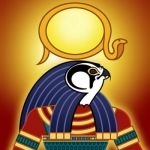
Reiner Knizia's Ra
Games and Entertainment
App
Summer Sale + 64bit update celebration! We are working hard to avoid the Appocalypse - help support...
Gareth von Kallenbach (980 KP) rated Halloween Ends (2022) in Movies
Oct 14, 2022 (Updated Oct 14, 2022)
Halloween Ends Closes The New Trilogy With What Fans Expect
The final film I the new “Halloween” trilogy has arrived with “Halloween
Ends” and it looks to bring closure to the character of Laurie Strode
(Jamie Lee Curtis) and the terror of Michael Myers.
The film takes place about four years after the events of “Halloween
Kills” and Michael has not been seen since leaving some to speculate that
he died while others are convinced he is still out there. The fear brought
on by Myers still hangs over the community and suicides and other horrific
aftermaths of his terror keeps the community from healing and moving on.
Laurie has decided to write a book about her experiences and while raising
her Granddaughter Allyson (And Matichak), she is coming to peace with her
life and has even awkwardly flirted with Officer Hawkins (Will Patton).
When a young man named Corey (Rohan Campbell), is involved in a tragic
event, he is marked as a psycho by the community and is often the subject
of abuse from the locals. Laurie sees a person in need and introduces him
to Allyson which starts a relationship that should help both of them heal
and move on.
When Corey is roughed up by locals, he discovers Michael is indeed alive
and well and Michael sees something in Corey due to his past and lets him
live. This sparks a change in Corey as he starts to manifest a darker side
where killing and revenge are his motivations and Michael is his mentor.
At this point it seemed as if the film would be a tale of revenge and
Michael would be grooming a potential replacement but it actually becomes
a bit convoluted as the film seems to be unsure of which storylines to
advance. After a slow start in the carnage department, the body count
rises quickly but without the pacing and tension normally associated with
the best films in the series.
It all leads up to a final confrontation between Michael and Laurie which
should delight fans as Curtis is truly magnificent and there brutal and
deadly dance had the audience cheering during my press screening.
While one device I saw coming a mile away as it was clear someone would be
dealing with it, the film does deliver even if the plot is more muddled
than fans would like. While it does not reach the greatness of the new
reboot, “Halloween Ends” is a fitting finale and is better than several of
the films in the series that followed it, the biggest issue is that the
first film in the trilogy set such a high standard, it was nearly
impossible of the next two films to measure up.
3 stars out of 5
Ends” and it looks to bring closure to the character of Laurie Strode
(Jamie Lee Curtis) and the terror of Michael Myers.
The film takes place about four years after the events of “Halloween
Kills” and Michael has not been seen since leaving some to speculate that
he died while others are convinced he is still out there. The fear brought
on by Myers still hangs over the community and suicides and other horrific
aftermaths of his terror keeps the community from healing and moving on.
Laurie has decided to write a book about her experiences and while raising
her Granddaughter Allyson (And Matichak), she is coming to peace with her
life and has even awkwardly flirted with Officer Hawkins (Will Patton).
When a young man named Corey (Rohan Campbell), is involved in a tragic
event, he is marked as a psycho by the community and is often the subject
of abuse from the locals. Laurie sees a person in need and introduces him
to Allyson which starts a relationship that should help both of them heal
and move on.
When Corey is roughed up by locals, he discovers Michael is indeed alive
and well and Michael sees something in Corey due to his past and lets him
live. This sparks a change in Corey as he starts to manifest a darker side
where killing and revenge are his motivations and Michael is his mentor.
At this point it seemed as if the film would be a tale of revenge and
Michael would be grooming a potential replacement but it actually becomes
a bit convoluted as the film seems to be unsure of which storylines to
advance. After a slow start in the carnage department, the body count
rises quickly but without the pacing and tension normally associated with
the best films in the series.
It all leads up to a final confrontation between Michael and Laurie which
should delight fans as Curtis is truly magnificent and there brutal and
deadly dance had the audience cheering during my press screening.
While one device I saw coming a mile away as it was clear someone would be
dealing with it, the film does deliver even if the plot is more muddled
than fans would like. While it does not reach the greatness of the new
reboot, “Halloween Ends” is a fitting finale and is better than several of
the films in the series that followed it, the biggest issue is that the
first film in the trilogy set such a high standard, it was nearly
impossible of the next two films to measure up.
3 stars out of 5
Movie Metropolis (309 KP) rated The Hunger Games (2012) in Movies
Jun 10, 2019
Director Gary Ross had his work cut out trying to create a film which brought to life the startling realism of Suzanne Collins’ successful trilogy of novels and here we have the first, The Hunger Games.
This film has come at a time where movie fans have been released from the clawing hooks of the Harry Potter franchise and the finale of the Twilight Saga is now on the horizon. Some would say, it’s the perfect time to begin a new franchise and for the most part, they’re right. Move over witches and vampires, there’s a new, more mature kid ready to take your crowns.
I for one went into The Hunger Games trilogy blindfolded. I have not read the books so this review is purely based on the film I saw before me and I must say; I was mightily impressed.
The film is set some way in the future and the world is a much different place; in a place called Panem (a post-apocalyptic North America) is where we find 12 Districts full of variety with different races living alongside each other, just as we have today. However, there is a more sinister side to things as we learn that once a year; The Hunger Games tournament takes place.
For those of you not familiar with the event itself, here’s a brief description. Each year, one boy and one girl aged between 12 and 18 from each district fights to the death until there is one winner, showered with riches for the remainder of their lives.
Jennifer Lawrence of X-Men First Class fame stars as Katniss Everdeen, a plucky young girl brought up in the coal mining community of District 12. After her young sister is picked to represent District 12, she decides the only thing to do is nominate herself and save her from certain death. Her male counterpart is Peeta Mellark played by a mature looking Josh Hutcherson of Journey to the Centre of the Earth fame.
Once the pair have been selected, they are taken to Capitol, a city brimming with the wealthy, a stark contrast to the coal mining community our District 12 heroes come from. Woody Harrelson stars as a previous winner of the games and the District 12 mentor, he takes it upon himself to train the ‘tributes’ and prepare them for the task ahead.
Once in battle, all chaos ensues and this is where the film begins to partially unravel. The actors and actresses all do excellent jobs, in particular Lawrence plays Katniss exceptionally well, her soft side comes through but you never forget her harsher, hunter like persona. Unfortunately, the action is held back by the ridiculous 12A certification the film has been lumbered with. It has become the case, as with The Woman in Black earlier this year that films based on best-selling and well known books or with teen stars have to be given this frankly dire classification. The violence is toned down to such a level that it becomes unrealistic and from what I have read, The Hunger Games is a much more brutal and unforgiving experience as a novel.
Other negatives include some shoddy CGI and too much hand based camera work, the battles at the beginning of the games are messy and not enjoyable to sit through. It’s a disappointing lapse in a film which is actually very good indeed.
Thankfully, the lengthy running time allows the final third to pick up nicely to leave you with a lasting impression.
The Hunger Games had the unenviable task of being on the receiving end of comparisons to Harry Potter and the Twilight franchises, and to an extent it has done its source material proud. Does it live up to the much-loved world of Hogwarts? Probably not. Does it live up to the lust and romance of the Twilight Saga? Most definitely. It sits, right smack in the middle and that’s not a bad place to be.
Gary Ross has produced a fine blockbuster with excellent performances from the cast and some fabulous design choices. Yes, it’s a little too long, there are some shoddy special effects and the character development lacks depth, but for fans of the series and newcomers alike, it moves the game on and is an enjoyable experience.
https://moviemetropolis.net/2012/04/05/the-hunger-games-2012-review/
This film has come at a time where movie fans have been released from the clawing hooks of the Harry Potter franchise and the finale of the Twilight Saga is now on the horizon. Some would say, it’s the perfect time to begin a new franchise and for the most part, they’re right. Move over witches and vampires, there’s a new, more mature kid ready to take your crowns.
I for one went into The Hunger Games trilogy blindfolded. I have not read the books so this review is purely based on the film I saw before me and I must say; I was mightily impressed.
The film is set some way in the future and the world is a much different place; in a place called Panem (a post-apocalyptic North America) is where we find 12 Districts full of variety with different races living alongside each other, just as we have today. However, there is a more sinister side to things as we learn that once a year; The Hunger Games tournament takes place.
For those of you not familiar with the event itself, here’s a brief description. Each year, one boy and one girl aged between 12 and 18 from each district fights to the death until there is one winner, showered with riches for the remainder of their lives.
Jennifer Lawrence of X-Men First Class fame stars as Katniss Everdeen, a plucky young girl brought up in the coal mining community of District 12. After her young sister is picked to represent District 12, she decides the only thing to do is nominate herself and save her from certain death. Her male counterpart is Peeta Mellark played by a mature looking Josh Hutcherson of Journey to the Centre of the Earth fame.
Once the pair have been selected, they are taken to Capitol, a city brimming with the wealthy, a stark contrast to the coal mining community our District 12 heroes come from. Woody Harrelson stars as a previous winner of the games and the District 12 mentor, he takes it upon himself to train the ‘tributes’ and prepare them for the task ahead.
Once in battle, all chaos ensues and this is where the film begins to partially unravel. The actors and actresses all do excellent jobs, in particular Lawrence plays Katniss exceptionally well, her soft side comes through but you never forget her harsher, hunter like persona. Unfortunately, the action is held back by the ridiculous 12A certification the film has been lumbered with. It has become the case, as with The Woman in Black earlier this year that films based on best-selling and well known books or with teen stars have to be given this frankly dire classification. The violence is toned down to such a level that it becomes unrealistic and from what I have read, The Hunger Games is a much more brutal and unforgiving experience as a novel.
Other negatives include some shoddy CGI and too much hand based camera work, the battles at the beginning of the games are messy and not enjoyable to sit through. It’s a disappointing lapse in a film which is actually very good indeed.
Thankfully, the lengthy running time allows the final third to pick up nicely to leave you with a lasting impression.
The Hunger Games had the unenviable task of being on the receiving end of comparisons to Harry Potter and the Twilight franchises, and to an extent it has done its source material proud. Does it live up to the much-loved world of Hogwarts? Probably not. Does it live up to the lust and romance of the Twilight Saga? Most definitely. It sits, right smack in the middle and that’s not a bad place to be.
Gary Ross has produced a fine blockbuster with excellent performances from the cast and some fabulous design choices. Yes, it’s a little too long, there are some shoddy special effects and the character development lacks depth, but for fans of the series and newcomers alike, it moves the game on and is an enjoyable experience.
https://moviemetropolis.net/2012/04/05/the-hunger-games-2012-review/
Lee (2222 KP) rated The Lion King (2019) in Movies
Jul 20, 2019 (Updated Jul 20, 2019)
Disney's 1994 animated version of The Lion King was a huge hit. Not only did it win Academy Awards for original score (courtesy of the amazing Hans Zimmer) but also for original song "Can You Feel the Love Tonight" by Elton John & Tim Rice. It also won a Golden Globe for Best Motion Picture - Musical or Comedy and went on to become a huge Broadway stage show in 1997, winning further awards and proving to be one of the most popular shows ever. Some movie sequels quietly came and went, along with a couple of TV series, but it's the original movie which is still loved by millions to this day. While Disney currently feels the need to rework their animated back catalogue, and with considerable advances in photorealistic computer animation technology, it was only a matter of time before The Lion King had it's turn in landing a remake.
Right now, I'm neither for or against this current wave of remakes. I don't think they're entirely necessary, but I've been pleasantly surprised by one or two of them so far, so I'm happy to give them my time for now. The Lion King is the third remake to emerge this year though, following the disappointing Dumbo and the not as bad as I was expecting Aladdin. The term 'live action' has been used to describe this version of The Lion King, although it's not really live - more of a CGI upgrade - and it's been getting a lot of negativity online too, more so than any other Disney remake so far. Most of the backlash appears to be down to the fact that this is a beloved film, with the remake being more of a shot by shot recreation than any of the others so far, supposedly rendering it unnecessary in the eyes of the haters. But, while I agree that the original is an incredible movie, that certainly didn't stop me, or millions of others, from going to view the stage show production of The Lion King - a retelling and re-imagining of the story and characters you know and love, just with a different set of tools to do the job. So, why not treat this new movie in the same way, at least until you've actually seen it? And, even if you do hate the new version, the original is still going to be there for you to enjoy afterwards.
The story here, as mentioned earlier, is the same as the original movie, with a pretty impressive cast lending their voices to the characters. We follow young lion cub Simba (JD McCrary), who is destined to succeed his father, Mufasa (James Earl Jones reprising his 1994 performance), as King of the African Pride Lands. But his uncle Scar (Chiwetel Ejiofor) has other plans, murdering Mufasa and forcing Simba into exile where he meets a warthog called Pumbaa (Seth Rogen) and a meerkat named Timon (Billy Eichner). As an adult, Simba (now voiced by Donald Glover) reconnects with childhood friend Nala (voiced by Shahadi Wright Joseph as a child, Beyoncé as an adult) and mandrill Rafkiki (John Kani) and returns to the Pride Lands in order to take his rightful place as King. The circle of life, etc...
The visuals are incredible. Director Jon Favreau, who also directed the 2016 version of The Jungle Book, has taken what was done on that movie to a whole new level here. But the imagery is both the movies strength and it's weakness. As we sweep across the African landscape, in and around the animals as they go about their lives, you feel as though you are in a beautifully well shot documentary, the animals are that realistic. But that realism also means that animals cannot realistically convey human expressions or emotions, and there's a lot to be conveyed in the story of The Lion King - laughter, anger, sadness - and the majority of the voice cast cannot seem to stop it all from just feeling a bit flat and lifeless.
The first half meanders along, hitting all the right beats and songs from the original, but never really feeling like an improvement on it. And then Timon and Pumbaa arrive on the scene, providing much needed laughs and proving to be the movie's saviours. The film finds its feet, lightens up a little and becomes more enjoyable for its remainder, but it isn't enough. This is yet another remake where it's all style and not enough substance. Worth seeing, but certainly not better than the original.
https://www.cinechat.co.uk/the-lion-king-2019-review/
Right now, I'm neither for or against this current wave of remakes. I don't think they're entirely necessary, but I've been pleasantly surprised by one or two of them so far, so I'm happy to give them my time for now. The Lion King is the third remake to emerge this year though, following the disappointing Dumbo and the not as bad as I was expecting Aladdin. The term 'live action' has been used to describe this version of The Lion King, although it's not really live - more of a CGI upgrade - and it's been getting a lot of negativity online too, more so than any other Disney remake so far. Most of the backlash appears to be down to the fact that this is a beloved film, with the remake being more of a shot by shot recreation than any of the others so far, supposedly rendering it unnecessary in the eyes of the haters. But, while I agree that the original is an incredible movie, that certainly didn't stop me, or millions of others, from going to view the stage show production of The Lion King - a retelling and re-imagining of the story and characters you know and love, just with a different set of tools to do the job. So, why not treat this new movie in the same way, at least until you've actually seen it? And, even if you do hate the new version, the original is still going to be there for you to enjoy afterwards.
The story here, as mentioned earlier, is the same as the original movie, with a pretty impressive cast lending their voices to the characters. We follow young lion cub Simba (JD McCrary), who is destined to succeed his father, Mufasa (James Earl Jones reprising his 1994 performance), as King of the African Pride Lands. But his uncle Scar (Chiwetel Ejiofor) has other plans, murdering Mufasa and forcing Simba into exile where he meets a warthog called Pumbaa (Seth Rogen) and a meerkat named Timon (Billy Eichner). As an adult, Simba (now voiced by Donald Glover) reconnects with childhood friend Nala (voiced by Shahadi Wright Joseph as a child, Beyoncé as an adult) and mandrill Rafkiki (John Kani) and returns to the Pride Lands in order to take his rightful place as King. The circle of life, etc...
The visuals are incredible. Director Jon Favreau, who also directed the 2016 version of The Jungle Book, has taken what was done on that movie to a whole new level here. But the imagery is both the movies strength and it's weakness. As we sweep across the African landscape, in and around the animals as they go about their lives, you feel as though you are in a beautifully well shot documentary, the animals are that realistic. But that realism also means that animals cannot realistically convey human expressions or emotions, and there's a lot to be conveyed in the story of The Lion King - laughter, anger, sadness - and the majority of the voice cast cannot seem to stop it all from just feeling a bit flat and lifeless.
The first half meanders along, hitting all the right beats and songs from the original, but never really feeling like an improvement on it. And then Timon and Pumbaa arrive on the scene, providing much needed laughs and proving to be the movie's saviours. The film finds its feet, lightens up a little and becomes more enjoyable for its remainder, but it isn't enough. This is yet another remake where it's all style and not enough substance. Worth seeing, but certainly not better than the original.
https://www.cinechat.co.uk/the-lion-king-2019-review/
Gareth von Kallenbach (980 KP) rated In Time (2011) in Movies
Aug 7, 2019
t is said that time is money and in the new film “In Time” this statement takes on an entirely new meaning. In the future we learn that humans have been genetically created to stop aging at the age of 25. Once they reach this selected age, a clock starts to count down from one year. People can obtain more time via work, stealing it from others, or being gifted more time but once their clock hits zero, they expire or “Time Out” as it is called.
As the film opens, we are introduced to Will Salas (Justin Timberlake), a man who is three years past twenty five who lives at home with his mother (Olivia Wilde). Will starts each day with barely enough time on his clock for another day, so he dutifully heads off to work each day to earn more time. As does his mother and everyone he knows since workers are paid at the end of their shifts by having more time added to their accounts. Many need to work daily in order to see the next day. To stop working is to die and since everything from food to rent and clothing is paid for in time from an individual’s account, they often have to make the choice between a transaction or more hours of life.
One evening after work, Will encounters a man named Henry (Matt Bomer), with over 100 years remaining on his clock and cautions the man that in this area he is likely to attract thieves. Will’s warnings go unheeded and soon a group of thugs arrive forcing Will to whisk the man away to safety. During their night in hiding, the man tells Will that after living for over a century, he is tired of the way the system is and how the rich can live forever while the working poor suffer just to live another day.
Will awakens the next morning to find the man gone and that his clock has now been credited the 100 years. Will locates the man just in time to watch him time out with a smile as he watches the sun rise. Flush with new wealth, Will plans to move his mother out of the slums and into a better life but when tragedy strikes, Will decides to move to where the wealth is as to take them for all he can.
Will soon finds himself in a high stakes card game at a casino and in a desperate move finds himself wealthier than he ever imagined. His actions impress very wealthy banking magnet Philippie Weiss (Vincent Kartheiser), who introduces him to his daughter Sylvia (Amanda Seyfried). Will and Sylvia hit it off as she is intrigued by someone who came into money rather than being born with it and imagines what life would be like with some excitement.
Will and Sylvia soon have their worlds turned upside down when Will is suspected in the death of Henry and find themselves on the run from a Timekeeper named Raymond (Cillian Murphy), who wants to bring Will to justice. In a rapid series of events, Will and Sylvia must contend with Raymond, criminals, and a series of unsavory characters to regain their lost time before it is to late so they can implement their master plan to truly make a difference.
The film has some great social commentary and a great cast but is hindered by trying to be too many things. It works well as a science fiction film with elements of action and romance. Sadly the film goes off course by having Will and Sylvia act as a modern day Robin Hood duo taking on the powers-that-be to save the downtrodden masses. While it is a noble effort it derailed the momentum of the story as much of the tension and mystery of the story was lost. If one is wanted by thugs and the authorities, I would think that knocking over one high profile time bank after another would not be the way to keep a low profile.
That being said, despite the flaws, the film works and I found myself thinking about the characters and the setting they lived in days after the I screened the film. I had been concerned that the film would be nothing more than a knockoff of “Logan’s Run” but thankfully the film had enough new content to keep it fresh and interesting. In many ways, “In Time” is science fiction at its best as it allows for timely social commentary and provides a disturbing look at many age old debates on society’s endless quests for wealth, power, and youth.
As the film opens, we are introduced to Will Salas (Justin Timberlake), a man who is three years past twenty five who lives at home with his mother (Olivia Wilde). Will starts each day with barely enough time on his clock for another day, so he dutifully heads off to work each day to earn more time. As does his mother and everyone he knows since workers are paid at the end of their shifts by having more time added to their accounts. Many need to work daily in order to see the next day. To stop working is to die and since everything from food to rent and clothing is paid for in time from an individual’s account, they often have to make the choice between a transaction or more hours of life.
One evening after work, Will encounters a man named Henry (Matt Bomer), with over 100 years remaining on his clock and cautions the man that in this area he is likely to attract thieves. Will’s warnings go unheeded and soon a group of thugs arrive forcing Will to whisk the man away to safety. During their night in hiding, the man tells Will that after living for over a century, he is tired of the way the system is and how the rich can live forever while the working poor suffer just to live another day.
Will awakens the next morning to find the man gone and that his clock has now been credited the 100 years. Will locates the man just in time to watch him time out with a smile as he watches the sun rise. Flush with new wealth, Will plans to move his mother out of the slums and into a better life but when tragedy strikes, Will decides to move to where the wealth is as to take them for all he can.
Will soon finds himself in a high stakes card game at a casino and in a desperate move finds himself wealthier than he ever imagined. His actions impress very wealthy banking magnet Philippie Weiss (Vincent Kartheiser), who introduces him to his daughter Sylvia (Amanda Seyfried). Will and Sylvia hit it off as she is intrigued by someone who came into money rather than being born with it and imagines what life would be like with some excitement.
Will and Sylvia soon have their worlds turned upside down when Will is suspected in the death of Henry and find themselves on the run from a Timekeeper named Raymond (Cillian Murphy), who wants to bring Will to justice. In a rapid series of events, Will and Sylvia must contend with Raymond, criminals, and a series of unsavory characters to regain their lost time before it is to late so they can implement their master plan to truly make a difference.
The film has some great social commentary and a great cast but is hindered by trying to be too many things. It works well as a science fiction film with elements of action and romance. Sadly the film goes off course by having Will and Sylvia act as a modern day Robin Hood duo taking on the powers-that-be to save the downtrodden masses. While it is a noble effort it derailed the momentum of the story as much of the tension and mystery of the story was lost. If one is wanted by thugs and the authorities, I would think that knocking over one high profile time bank after another would not be the way to keep a low profile.
That being said, despite the flaws, the film works and I found myself thinking about the characters and the setting they lived in days after the I screened the film. I had been concerned that the film would be nothing more than a knockoff of “Logan’s Run” but thankfully the film had enough new content to keep it fresh and interesting. In many ways, “In Time” is science fiction at its best as it allows for timely social commentary and provides a disturbing look at many age old debates on society’s endless quests for wealth, power, and youth.
Gareth von Kallenbach (980 KP) rated The Lion King (2019) in Movies
Jul 11, 2019
It seems recently that the Disney vault has exploded with the release of several of their classic animated films being remade. Unfortunately, the classics that have inspired these remakes have been redone with mixed results. The original The Lion King was released back in 1994 and it’s hard to believe that I was a junior in college when I saw it. Since that time, we’ve seen various iterations of the classic story, a few direct to VCR sequels and the awe-inspiring Broadway stage production (which if you are a serious fan of the movie I encourage you to see). It seems odd to discuss the plot of a movie that I’m certain everyone reading this has seen at least once (or a dozen times over). To the uninformed however, The Lion King is about a young cub named Simba (JD McCrary as the young voice and Donald Glover as the adult) who suffers the tragic loss of his father Mufasa (James Earl Jones) at the paws of his evil uncle Scar (Chiwetel Ejiofor). Scar convinces Simba that he is responsible for his father’s death and that he must leave the pride and never return. With the help of his faithful friends Timon (Billy Eichner), the lovable warthog Pumbaa (Seth Rogen), the ever wise Zazu (John Oliver) and his budding queen Nala (Beyoncé’) he learns that true courage comes from within and realizes he must face Scar if he is ever to bring peace back to the Pride Lands.
Given the recent track record, I wasn’t sure if this was going to be a retelling of the story as I remembered it, or a re-imagining of the story as a whole (and yes there is a difference). Thankfully, I can say that The Lion King draws practically all of its inspiration directly from the animated classic. Director Jon Favreau (who had already wowed audiences when he directed The Jungle Book) brings the same heart-warming, tear jerk moments that we all know and love. While he certainly didn’t take any risks with The Lion King, that’s exactly what made it such a pleasure to behold. He understood that there was no need to change the story into something new or try to make it something it shouldn’t be. True, for those who have seen the animated film it will feel incredibly familiar, but I think that’s exactly what fans are looking for. Changes and risks don’t always make a movie better, and The Lion King is a prime example of not breaking something that works.
The real star of the show however isn’t the actors, nor it’s incredible director, but the technology that went behind bringing our favorite felines to life. Disney refers to this as a “photo real movie”. The technology behind it merges both new and old together to bring the animals to life, indistinguishable from their real-life counterparts. Utilizing VR, animation and mixed with live action film-making it is practically impossible to distinguish what is live and what is animated. The character models have come a far way from the original Jumanji, which was heralded back in 1995 for it’s use of computer animated animals that supposedly looked and felt like the real thing. While Disney has always made great strides to make their computer-generated animals look and feel real (much like the absolutely stunning Jungle Book) The Lion King takes this to an entirely different level altogether.
Disney has done what has seemed practically impossible lately, bringing a classic back to the screen without changing what made the original such a classic. Unlike some of their more recent attempts, The Lion King holds true to the source material which has delighted fans for over 25 years. While the story doesn’t bring anything particularly new to the table, the photo realistic lions and their supporting cast feel as fresh as they ever have. If you aren’t a fan of the classic animated movie, The Lion King won’t necessarily change that, however the imagery alone may be reason enough to see it. I hope Disney takes note of this movie in particular, that fans don’t need a re-imagining of the stories that captivated our youths to bring the magic back. The Lion King is a testament to how the Disney classic still holds up today, and how to make something old feel new again.
http://sknr.net/2019/07/11/the-lion-king/
Given the recent track record, I wasn’t sure if this was going to be a retelling of the story as I remembered it, or a re-imagining of the story as a whole (and yes there is a difference). Thankfully, I can say that The Lion King draws practically all of its inspiration directly from the animated classic. Director Jon Favreau (who had already wowed audiences when he directed The Jungle Book) brings the same heart-warming, tear jerk moments that we all know and love. While he certainly didn’t take any risks with The Lion King, that’s exactly what made it such a pleasure to behold. He understood that there was no need to change the story into something new or try to make it something it shouldn’t be. True, for those who have seen the animated film it will feel incredibly familiar, but I think that’s exactly what fans are looking for. Changes and risks don’t always make a movie better, and The Lion King is a prime example of not breaking something that works.
The real star of the show however isn’t the actors, nor it’s incredible director, but the technology that went behind bringing our favorite felines to life. Disney refers to this as a “photo real movie”. The technology behind it merges both new and old together to bring the animals to life, indistinguishable from their real-life counterparts. Utilizing VR, animation and mixed with live action film-making it is practically impossible to distinguish what is live and what is animated. The character models have come a far way from the original Jumanji, which was heralded back in 1995 for it’s use of computer animated animals that supposedly looked and felt like the real thing. While Disney has always made great strides to make their computer-generated animals look and feel real (much like the absolutely stunning Jungle Book) The Lion King takes this to an entirely different level altogether.
Disney has done what has seemed practically impossible lately, bringing a classic back to the screen without changing what made the original such a classic. Unlike some of their more recent attempts, The Lion King holds true to the source material which has delighted fans for over 25 years. While the story doesn’t bring anything particularly new to the table, the photo realistic lions and their supporting cast feel as fresh as they ever have. If you aren’t a fan of the classic animated movie, The Lion King won’t necessarily change that, however the imagery alone may be reason enough to see it. I hope Disney takes note of this movie in particular, that fans don’t need a re-imagining of the stories that captivated our youths to bring the magic back. The Lion King is a testament to how the Disney classic still holds up today, and how to make something old feel new again.
http://sknr.net/2019/07/11/the-lion-king/
